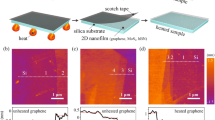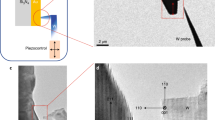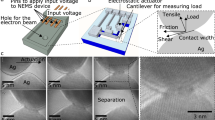Abstract
Friction at the nanoscale has revealed a wealth of behaviours that depart strongly from the long-standing macroscopic laws of Amontons–Coulomb1,2. Here, by using a ‘Christmas cracker’-type of system in which a multiwalled nanotube is torn apart between a quartz-tuning-fork-based atomic force microscope (TF–AFM) and a nanomanipulator, we compare the mechanical response of multiwalled carbon nanotubes (CNTs) and multiwalled boron nitride nanotubes (BNNTs) during the fracture and telescopic sliding of the layers. We found that the interlayer friction for insulating BNNTs results in ultrahigh viscous-like dissipation that is proportional to the contact area, whereas for the semimetallic CNTs the sliding friction vanishes within experimental uncertainty. We ascribe this difference to the ionic character of the BN, which allows charge localization. The interlayer viscous friction of BNNTs suggests that BNNT membranes could serve as extremely efficient shock-absorbing surfaces.
This is a preview of subscription content, access via your institution
Access options
Subscribe to this journal
Receive 12 print issues and online access
$259.00 per year
only $21.58 per issue
Buy this article
- Purchase on Springer Link
- Instant access to full article PDF
Prices may be subject to local taxes which are calculated during checkout



Similar content being viewed by others
References
Vanossi, A., Manini, N., Urbakh, M., Zapperi, S. & Tosatti, E. Modeling friction: From nanoscale to mesoscale. Rev. Mod. Phys. 85, 529 (2013).
Persson, B. N. J. Sliding Friction — Physical Principle and Applications 2nd edn (Springer, 2000).
Krim, J. Friction and energy dissipation mechanisms in adsorbed molecules and molecularly thin films. Adv. Phys. 61, 155–323 (2012).
Dienwiebel, M. et al. Superlubricity of graphite. Phys. Rev. Lett. 92, 126101 (2004).
Urbakh, M. & Meyer, E. The renaissance of friction. Nature Mater. 9, 8–10 (2010).
Socoliuc, A. et al. Atomic-scale control of friction by actuation of nanometer-sized contacts. Science 313, 207–210 (2006).
Lee, C. et al. Frictional characteristics of atomically thin sheets. Science 328, 76–80 (2010).
Lucas, M. et al. Hindered rolling and friction anisotropy in supported nanotubes. Nature Mater. 87, 876–881 (2009).
Jacobs, T. D. B. & Carpick, R. W. Nanoscale wear as a stress-assisted chemical reaction. Nature Nanotech. 8, 108–112 (2013).
Kisiel, M. et al. Suppression of electronic friction on Nb films in the superconducting state. Nature Mater. 10, 119–122 (2011).
Ogletree, D. F., Park, J. Y., Salmeron, M. & Thiel, P. A. Electronic control of friction in silicon pn junctions. Science 313, 186 (2006).
Gostman, B. Tribology: sliding on vacuum. Nature Mater. 10, 87–88 (2011).
Siria, A. et al. Electron fluctuation induced resonance broadening in nano electromechanical systems: The origin of shear force in vacuum. Nano Lett. 12, 3551–3556 (2012).
Cumings, J. & Zettl, A. Low-friction nanoscale linear bearing realized from multiwall nanotubes. Science 289, 602–604 (2000).
Kis, A. Jensen, K. Aloni, S. Mickelson & W. Zettl, A. Interlayer forces and ultralow sliding friction in multiwalled carbon nanotubes. Phys. Rev. Lett. 97, 025501 (2006).
Zhang, R. et al. Superlubricity in centimetres-long double-walled carbon nanotubes under ambient conditions. Nature Nanotech. 8, 912–916 (2013).
Arenal, R., Blase, X. & Loiseau, A. Boron-nitride and boron-carbonitride nanotubes: synthesis, characterization and theory. Adv. Phys. 59, 101–179 (2010).
Siria, A. et al. Giant osmotic energy conversion in a single transmembrane boron nitride nanotube. Nature 494, 455–458 (2013).
Karrai, K. & Grober, R. D. Piezoelectric tip–sample distance control for near field optical microscopes. Appl. Phys. Lett. 66, 1842 (1995).
Giessibl, F. J. High-speed froce sensor for force microscopy and profilometry utilizing a quartz tuning fork. Appl. Phys. Lett. 73, 3956 (1998).
Labardi, M. & Allegrini, M. Non-contact friction force microscopy based on quartz tuning fork sensors. Appl. Phys. Lett. 89, 174104 (2006).
Rodrigues, M. et al. Probing the elastic properties of individual nanostructures by combining in-situ atomic force micrscopy and micro-X-ray diffraction. Appl. Phys. Lett. 94, 23109 (2009).
Perisanu, S. et al. Mechanical properties of SiC nanowires determined by scanning electron and field emission microscopies. Phys. Rev. B. 77, 165434 (2008).
Poncharal, P., Wang, Z. L., Ugarte, D. & de Heer, W. A. Electrostatic deflections and electromechanical resonances of carbon nanotubes. Science 283, 1513–1516 (1999).
Bechelany, M. et al. Preparation of BN microtubes/nanotubes with unique chemical process. J. Phys. Chem. C 112, 18325 (2008).
Celik-Aktas, A., Zuo, J-M., Stubbins, J. F., Tang, C. & Bando, Y. Double-helix structure in multiwall boron nitride nanotubes. Acta Crystallogr. A61, 533–541 (2005).
Garel, J. et al. Ultrahigh torsional stiffness and strength of boron nitride nanotubes. Nano Lett. 12, 6347–6352 (2012).
Chui, H- C., Dogan, S., Volkmann, M., Klinke, C. & Riedo, E. Adhesion and size dependent friction anisotropy in boron nitride nanotubes. Nanotechnology 23, 455706 (2012).
Acknowledgements
A.S. and L.B. thank M.L. Bocquet for many fruitful discussions on CNTs and BNNTs. P.P. and P.V. thank N. Blanchard for support in TEM imaging of the nanotubes. The authors acknowledge support of an ERC advanced grant, project Micromegas.
Author information
Authors and Affiliations
Contributions
A.S. conceived the project. A.N. performed the experiments. A.N., A.S. and L.B. performed the data analysis. A.N. and A.S. conceived and realized the experimental set-up. P.P. and P.V. characterized the nanotubes. A.S. and L.B. wrote the article with inputs from A.N. and P.P. A.S. and L.B. supervised the project.
Corresponding author
Ethics declarations
Competing interests
The authors declare no competing financial interests.
Supplementary information
Supplementary Information
Supplementary Information (PDF 1681 kb)
Rights and permissions
About this article
Cite this article
Niguès, A., Siria, A., Vincent, P. et al. Ultrahigh interlayer friction in multiwalled boron nitride nanotubes. Nature Mater 13, 688–693 (2014). https://doi.org/10.1038/nmat3985
Received:
Accepted:
Published:
Issue Date:
DOI: https://doi.org/10.1038/nmat3985
This article is cited by
-
Significant strengthening of copper-based composites using boron nitride nanotubes
International Journal of Minerals, Metallurgy and Materials (2023)
-
The first-principles phase diagram of monolayer nanoconfined water
Nature (2022)
-
Structural lubricity in soft and hard matter systems
Nature Communications (2020)
-
Unexpected large impact of small charges on surface frictions with similar wetting properties
Communications Chemistry (2020)
-
A smart friction control strategy enabled by CO2 absorption and desorption
Scientific Reports (2019)



